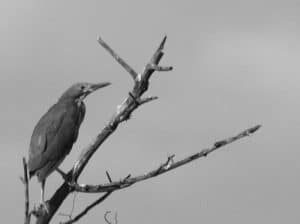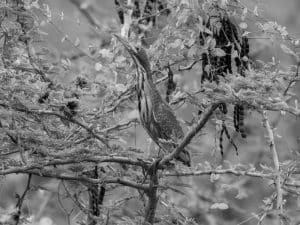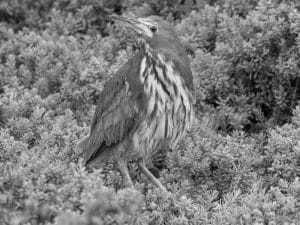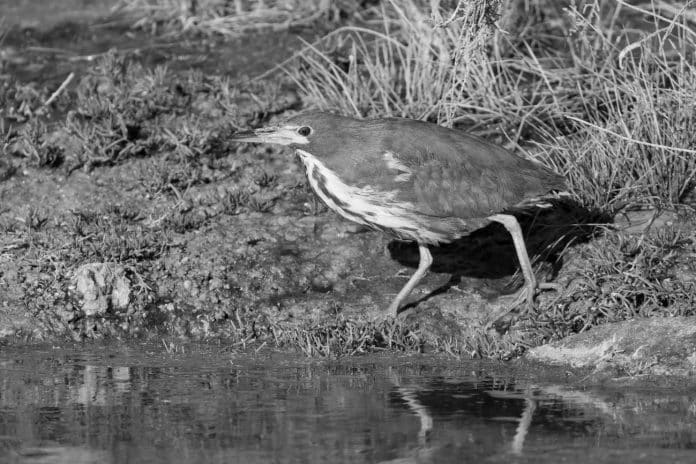Introduction to the Dwarf Bittern in Tanzania
The Dwarf Bittern in Tanzania, scientifically known as Ixobrychus sturmii, is a small heron that belongs to the Ardeidae family. It is primarily found in sub-Saharan Africa, including Tanzania, where it inhabits a variety of wetland habitats. This striking bird is known for its secretive nature, often remaining concealed within dense vegetation, making it a challenging but rewarding sighting for birdwatchers and wildlife enthusiasts.

The Dwarf Bittern is a master of camouflage, blending seamlessly with its surroundings, which makes it a true hidden gem of Tanzanian wetlands. Its plumage is predominantly brown and buff, with intricate patterns that provide excellent camouflage among the reeds and marshes where it resides. The male Dwarf Bittern is adorned with a distinctive black cap during the breeding season, adding a touch of elegance to its appearance.
Despite its small size, the Dwarf Bittern is a remarkable hunter, preying on small fish, amphibians, and insects within its wetland habitat. Its hunting strategy is characterized by patience and precision, as it patiently waits for the opportune moment to strike at its unsuspecting prey. This behavior adds to the mystique surrounding the Dwarf Bittern and makes observing its hunting prowess a captivating experience for wildlife enthusiasts.
Habitat and Distribution of the Dwarf Bittern
The Dwarf Bittern is primarily associated with freshwater wetlands, including marshes, swamps, and reedbeds, where it can find suitable cover and an abundance of prey. In Tanzania, these wetlands are scattered throughout various regions, providing diverse habitats for the Dwarf Bittern to thrive. The bird’s distribution in Tanzania encompasses both coastal and inland wetlands, showcasing its adaptability to different environments within the country.
One of the key factors contributing to the presence of Dwarf Bitterns in Tanzania is the country’s rich wetland ecosystems, which support a myriad of bird species, including migratory visitors. These wetlands not only serve as crucial habitats for resident birds but also attract avian travelers during their seasonal migrations. The presence of the Dwarf Bittern in these wetlands underscores the significance of preserving and protecting these vital ecosystems for the conservation of avian biodiversity.
Unique Characteristics and Behavior of the Dwarf Bittern
The Dwarf Bittern possesses a range of unique characteristics that set it apart from other heron species. Its diminutive size, intricate plumage patterns, and elusive nature make it a captivating subject for birdwatchers and photographers. The bird’s cryptic coloration allows it to blend seamlessly with the dense vegetation of its wetland habitats, providing effective camouflage from potential predators and human observers alike.
In addition to its physical attributes, the Dwarf Bittern’s behavior adds to its allure. Its secretive and solitary nature makes spotting this species a challenging yet immensely rewarding endeavor for birdwatching enthusiasts. The bird’s preference for remaining concealed within the reeds and marshes adds an element of mystery to its sightings, requiring patience, keen observation, and a bit of luck to catch a glimpse of this elusive avian gem.
Conservation Status and Efforts to Protect the Dwarf Bittern in Tanzania

The conservation status of the Dwarf Bittern is of significant concern due to the ongoing threats to its wetland habitats and the broader challenges faced by avian species across Africa. The International Union for Conservation of Nature (IUCN) has classified the Dwarf Bittern as a species of Least Concern, indicating that it is not currently considered to be at imminent risk of extinction. However, this designation does not diminish the need for proactive conservation measures to ensure the long-term survival of the species.
Tanzania has recognized the importance of its wetland ecosystems and the biodiversity they support, including the Dwarf Bittern. Conservation efforts aimed at protecting these vital habitats contribute to the overall well-being of the bird population and the ecological balance of the wetlands. Collaborative initiatives involving government authorities, conservation organizations, and local communities are instrumental in safeguarding the Dwarf Bittern’s habitats and raising awareness about the importance of preserving these natural landscapes.
Best Places to Spot the Dwarf Bittern in Tanzanian Wetlands
Tanzania boasts a diverse array of wetland habitats that provide prime opportunities for spotting the elusive Dwarf Bittern. From coastal marshes to inland swamps, the country offers a range of locations where birdwatchers and wildlife enthusiasts can seek out this captivating species. Among the best places to spot the Dwarf Bittern in Tanzanian wetlands are the following:
- Rubondo Island National Park: This island sanctuary in Lake Victoria is home to a variety of wetland habitats, including papyrus swamps and dense vegetation, providing ideal conditions for the Dwarf Bittern to thrive.
- Selous Game Reserve: The vast wetlands within this UNESCO World Heritage Site offer excellent birdwatching opportunities, with the chance to encounter the Dwarf Bittern amid the diverse array of avian and wildlife species.
- Kilombero Valley: The wetlands and floodplains of the Kilombero Valley are a haven for waterbirds, including the Dwarf Bittern, making it a promising location for birdwatching expeditions focused on this elusive species.
By exploring these and other wetland areas across Tanzania, birdwatchers and nature enthusiasts can immerse themselves in the beauty of the country’s natural landscapes while seeking out the captivating presence of the Dwarf Bittern.
Birdwatching Tours and Experiences Focused on the Dwarf Bittern
For those eager to embark on an immersive birdwatching experience centered on the Dwarf Bittern, specialized tours and guided expeditions offer the opportunity to delve into the world of this elusive heron species. These tours are designed to provide participants with expert guidance, in-depth knowledge of avian behavior, and the chance to observe and appreciate the unique characteristics of the Dwarf Bittern in its natural habitat.
Professional birdwatching guides and tour operators in Tanzania are well-versed in the diverse birdlife of the country and can tailor experiences to cater to the specific interests of birdwatchers, including a focus on the Dwarf Bittern. These specialized tours often include excursions to prime wetland areas, where participants can engage in dedicated birdwatching sessions, hone their observation skills, and gain insights into the conservation challenges and successes related to the Dwarf Bittern and its wetland habitats.
Participating in a birdwatching tour focused on the Dwarf Bittern not only offers the chance to observe this remarkable species up close but also contributes to the support and awareness of avian conservation efforts in Tanzania. By joining these immersive experiences, birdwatchers can appreciate the natural wonders of the country while contributing to the preservation of its avian biodiversity.
Photography Tips for Capturing the Beauty of the Dwarf Bittern
Capturing striking images of the Dwarf Bittern in its wetland habitat requires a combination of patience, skill, and an understanding of the bird’s behavior. For photographers seeking to immortalize the beauty of this elusive heron species, the following tips can enhance the quality and impact of their photographic endeavors:
- Understanding the bird’s behavior: Observing the habits and movements of the Dwarf Bittern is essential for anticipating its actions and capturing candid moments. By familiarizing oneself with the bird’s preferred perches, hunting techniques, and patterns of movement, photographers can increase their chances of capturing compelling images.
- Utilizing natural light: The play of light and shadow in wetland environments can create stunning visual effects, especially during the golden hours of sunrise and sunset. Photographers should leverage the soft, warm light of these times to enhance the beauty of the Dwarf Bittern and its surroundings.
- Maintaining a respectful distance: While seeking close-up shots of the Dwarf Bittern, photographers should prioritize the bird’s well-being and avoid causing undue stress or disturbance. Using long lenses and practicing ethical wildlife photography ensures that photographers can capture captivating images while minimizing their impact on the bird’s natural behavior.
By employing these photography tips and techniques, photographers can elevate their visual storytelling and showcase the captivating beauty of the Dwarf Bittern within the rich tapestry of Tanzanian wetlands.
Local Initiatives Supporting the Conservation of the Dwarf Bittern

Local communities and conservation organizations play a crucial role in supporting the conservation of the Dwarf Bittern and its wetland habitats in Tanzania. Through a range of initiatives focused on environmental stewardship, community engagement, and sustainable practices, these stakeholders contribute to the long-term well-being of the bird population and the preservation of its natural ecosystems.
One such initiative involves the establishment of community-based conservation areas within or adjacent to wetland habitats where the Dwarf Bittern resides. These areas serve as sanctuaries for wildlife, including the bird species, and promote the harmonious coexistence of human activities and biodiversity conservation. By empowering local communities to actively participate in the protection and management of these areas, these initiatives foster a sense of ownership and responsibility for the well-being of the Dwarf Bittern and its habitat.
Furthermore, educational programs and outreach efforts are instrumental in raising awareness about the significance of the Dwarf Bittern and the importance of preserving its wetland habitats. By engaging with local schools, community groups, and stakeholders, these initiatives promote a deeper understanding of the ecological value of the bird and inspire collective action toward its conservation.
The Significance of the Dwarf Bittern in Tanzanian Ecosystems
The presence of the Dwarf Bittern in Tanzanian wetlands holds significant ecological importance, contributing to the balance and resilience of these vital ecosystems. As a predator of small fish, amphibians, and insects, the bird plays a role in regulating the populations of its prey species, thereby influencing the dynamics of wetland food webs. By maintaining a healthy equilibrium within these ecosystems, the Dwarf Bittern contributes to the overall stability and functioning of the wetland environments, highlighting its ecological significance.
Furthermore, the Dwarf Bittern serves as an indicator species, reflecting the health and integrity of its wetland habitats. Its presence or absence can provide valuable insights into the condition of these ecosystems, signaling changes in water quality, habitat degradation, and other environmental factors that may impact the broader biodiversity of the wetlands. Monitoring the population trends and behaviors of the Dwarf Bittern offers a window into the well-being of Tanzanian wetlands and informs conservation strategies aimed at preserving these natural landscapes.
Conclusion
The Dwarf Bittern stands as a hidden gem within the diverse tapestry of Tanzanian wetlands, captivating observers with its elusive nature, unique characteristics, and ecological significance. As stewards of the natural world, it is imperative to recognize the value of this remarkable bird species and the ecosystems it inhabits. By supporting conservation efforts, engaging in responsible wildlife tourism, and fostering an appreciation for the beauty of the Dwarf Bittern, we can contribute to the preservation of Tanzania’s avian biodiversity and the enduring splendor of its wetland landscapes.


































